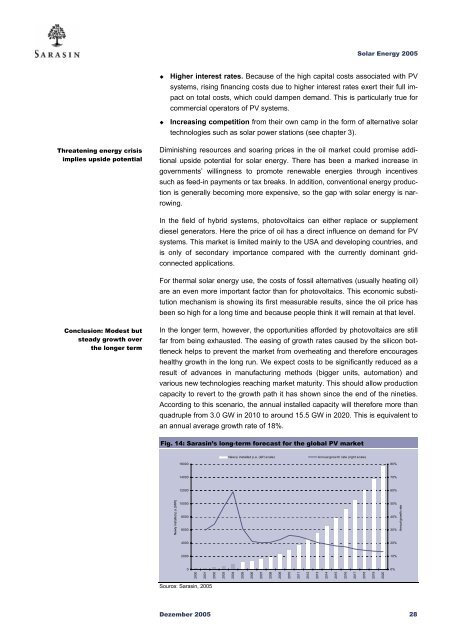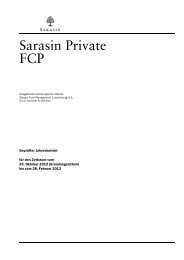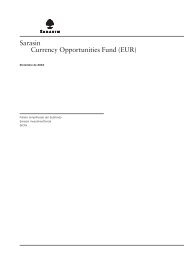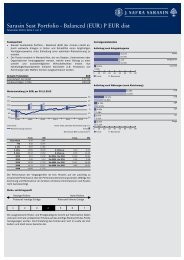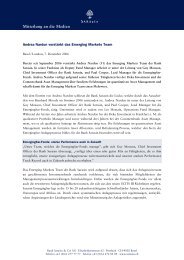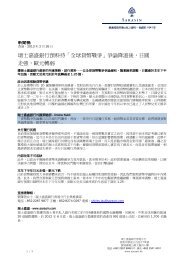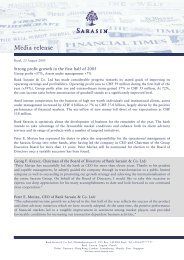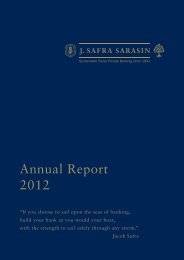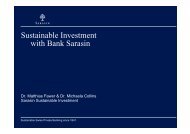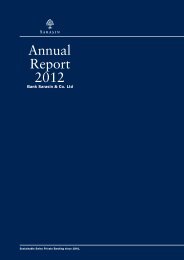Sustainability Report - Bank Sarasin-Alpen
Sustainability Report - Bank Sarasin-Alpen
Sustainability Report - Bank Sarasin-Alpen
Create successful ePaper yourself
Turn your PDF publications into a flip-book with our unique Google optimized e-Paper software.
Solar Energy 2005<br />
<br />
<br />
Higher interest rates. Because of the high capital costs associated with PV<br />
systems, rising financing costs due to higher interest rates exert their full impact<br />
on total costs, which could dampen demand. This is particularly true for<br />
commercial operators of PV systems.<br />
Increasing competition from their own camp in the form of alternative solar<br />
technologies such as solar power stations (see chapter 3).<br />
Threatening energy crisis<br />
implies upside potential<br />
Diminishing resources and soaring prices in the oil market could promise additional<br />
upside potential for solar energy. There has been a marked increase in<br />
governments’ willingness to promote renewable energies through incentives<br />
such as feed-in payments or tax breaks. In addition, conventional energy production<br />
is generally becoming more expensive, so the gap with solar energy is narrowing.<br />
In the field of hybrid systems, photovoltaics can either replace or supplement<br />
diesel generators. Here the price of oil has a direct influence on demand for PV<br />
systems. This market is limited mainly to the USA and developing countries, and<br />
is only of secondary importance compared with the currently dominant gridconnected<br />
applications.<br />
For thermal solar energy use, the costs of fossil alternatives (usually heating oil)<br />
are an even more important factor than for photovoltaics. This economic substitution<br />
mechanism is showing its first measurable results, since the oil price has<br />
been so high for a long time and because people think it will remain at that level.<br />
Conclusion: Modest but<br />
steady growth over<br />
the longer term<br />
In the longer term, however, the opportunities afforded by photovoltaics are still<br />
far from being exhausted. The easing of growth rates caused by the silicon bottleneck<br />
helps to prevent the market from overheating and therefore encourages<br />
healthy growth in the long run. We expect costs to be significantly reduced as a<br />
result of advances in manufacturing methods (bigger units, automation) and<br />
various new technologies reaching market maturity. This should allow production<br />
capacity to revert to the growth path it has shown since the end of the nineties.<br />
According to this scenario, the annual installed capacity will therefore more than<br />
quadruple from 3.0 GW in 2010 to around 15.5 GW in 2020. This is equivalent to<br />
an annual average growth rate of 18%.<br />
Fig. 14: <strong>Sarasin</strong>’s long-term forecast for the global PV market<br />
New ly installed p.a. (left scale)<br />
Annual grow th rate (right scale)<br />
16000<br />
80%<br />
14000<br />
70%<br />
12000<br />
60%<br />
10000<br />
8000<br />
6000<br />
4000<br />
2000<br />
0<br />
2000<br />
2001<br />
2002<br />
2003<br />
2004<br />
2005<br />
2006<br />
2007<br />
2008<br />
2009<br />
2010<br />
2011<br />
2012<br />
2013<br />
2014<br />
2015<br />
2016<br />
2017<br />
2018<br />
2019<br />
2020<br />
Newly installed p.a. [MW]<br />
50%<br />
40%<br />
30%<br />
Annual growth rate<br />
20%<br />
10%<br />
0%<br />
Source: <strong>Sarasin</strong>, 2005<br />
Dezember 2005 28


